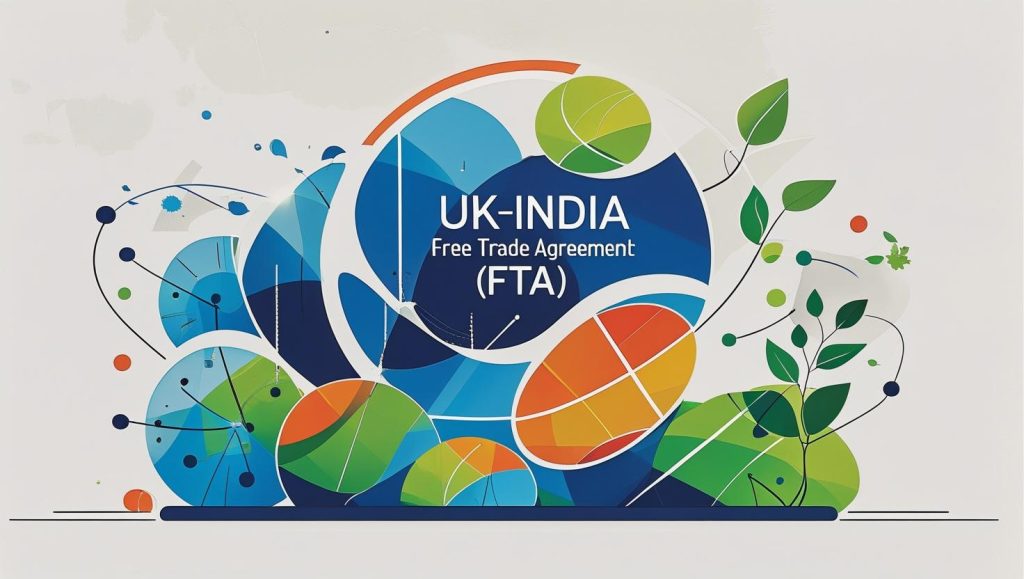Introduction
The finalization of the UK-India Free Trade Agreement (FTA) on May 6, 2025, marks a significant milestone in bilateral relations. Both the UK and Indian governments have lauded this deal as a strategic move to stimulate economic growth, boost exports and create new job opportunities.
This UK-India Free Trade Agreement is a comprehensive pact that aims to dismantle trade barriers and foster a more integrated economic partnership. The agreement is projected to provide a substantial economic boost and support job creation in key sectors for both nations.

Key Benefits of the Free Trade Agreement
This FTA is designed to provide enhanced market access for goods and services from both countries.
- Market Access: The agreement will eliminate tariffs on 99% of Indian tariff lines, covering nearly all of India’s trade value with the UK. For the UK, the Free Trade Agreement will reduce tariffs on 90% of its tariff lines. This is particularly beneficial for UK exports like whisky, automotive parts, and medical devices. Similarly, Indian sectors such as textiles, marine products, and leather will gain significant export opportunities. For instance, tariffs on UK whisky are set to decrease from 150% to 75% initially and further to 40% over a decade.
- Economic Growth and Jobs: The Free Trade Agreement is anticipated to increase the UK’s GDP and support substantial employment gains in India, especially in labour-intensive industries like textiles and footwear. The goal is to more than double the current bilateral trade value to US$100 billion (£75 billion) by 2030. This FTA is a central component of this ambitious growth strategy.
- Services and Professional Mobility: The Free Trade Agreement includes robust commitments for services, which will make Indian service providers more competitive in the UK market. A key feature of the Free Trade Agreement is the provision for easier mobility for professionals, including business visitors and contractual service suppliers. The inclusion of a Double Contribution Convention (DCC) will exempt Indian workers in the UK from social security contributions for up to three years, enhancing their financial competitiveness.
Challenges and Concerns
While the FTA presents immense opportunities, it’s also important to acknowledge some of the potential challenges and concerns.
- Impact on Local Industries: Some sectors in both countries may face increased competition. For example, local dairy producers in India have expressed concerns about competition from potentially cheaper UK dairy products. Similarly, some UK industries, such as textiles and apparel, may face stronger competition from Indian imports due to the removal of tariffs. To address this, the agreement includes bilateral safeguards to manage any sudden import surges.
- Rules of Origin: A critical component of this FTA is the “Rules of OOrigin”.To qualify for the tariff benefits, a product must prove it was substantially made in the UK or India. This can be quite complex and businesses will need to ensure their supply chains meet these criteria to avoid paying the standard tariffs.
- The Carbon Tax Issue: A point of discussion during the negotiations was the UK’s proposed carbon tax. Some experts believe this could potentially impact Indian exports in energy-intensive sectors like steel, even with a Free Trade Agreement in place. This is a complex issue that may require further resolution.
How to Prepare Your Business for the FTA
For businesses looking to capitalize on this Free Trade Agreement, proactive preparation is key.
- Understand the New Rules: The first step is to thoroughly review the official text of the UK-India Free Trade Agreement once available. Pay close attention to the specific tariff schedules and the Rules of Origin for your products. You can find detailed information on the Indian Ministry of Commerce and Industry website or the UK’s Department for Business and Trade portal.
- Review Your Supply Chain: Businesses should analyze their current supply chains to ensure they can meet the origin requirements of the FTA. This might involve working with suppliers to secure the necessary documentation or making adjustments to sourcing strategies.
- Seek Out Government Support: Both governments are expected to provide resources and support for businesses navigating the new trade landscape.
Conclusion
This UK-India Free Trade Agreement represents a forward-looking approach to trade, encompassing goods, services, and investment. While the specifics of the agreement, such as detailed tariff schedules and rules of origin, are still being awaited, stakeholders on both sides should prepare to leverage the opportunities presented by this new Free Trade Agreement.